Effective Risk Culture And Management
VerifiedAdded on 2022/08/26
|14
|3234
|16
AI Summary
Contribute Materials
Your contribution can guide someone’s learning journey. Share your
documents today.
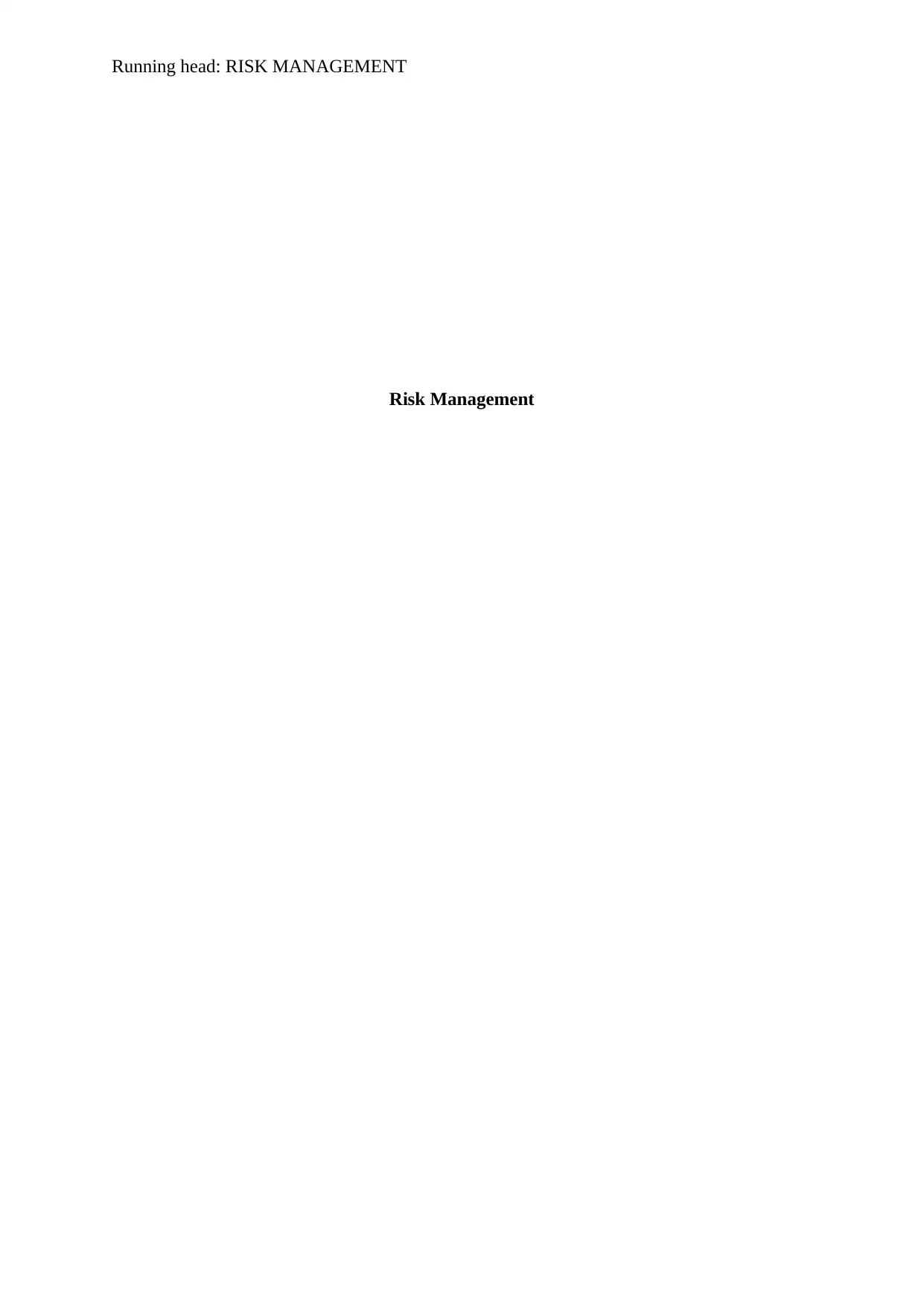
Running head: RISK MANAGEMENT
Risk Management
Risk Management
Secure Best Marks with AI Grader
Need help grading? Try our AI Grader for instant feedback on your assignments.
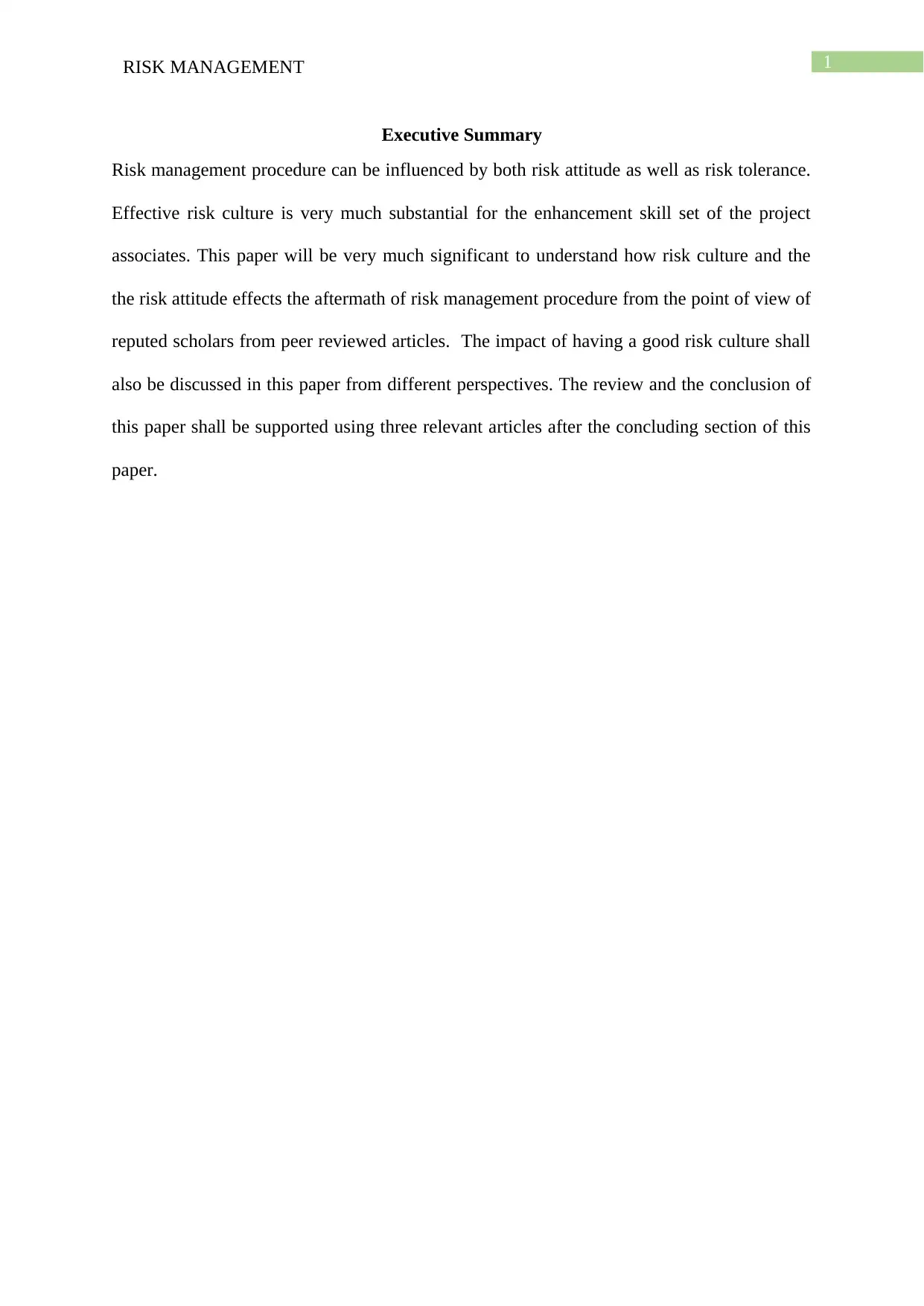
1RISK MANAGEMENT
Executive Summary
Risk management procedure can be influenced by both risk attitude as well as risk tolerance.
Effective risk culture is very much substantial for the enhancement skill set of the project
associates. This paper will be very much significant to understand how risk culture and the
the risk attitude effects the aftermath of risk management procedure from the point of view of
reputed scholars from peer reviewed articles. The impact of having a good risk culture shall
also be discussed in this paper from different perspectives. The review and the conclusion of
this paper shall be supported using three relevant articles after the concluding section of this
paper.
Executive Summary
Risk management procedure can be influenced by both risk attitude as well as risk tolerance.
Effective risk culture is very much substantial for the enhancement skill set of the project
associates. This paper will be very much significant to understand how risk culture and the
the risk attitude effects the aftermath of risk management procedure from the point of view of
reputed scholars from peer reviewed articles. The impact of having a good risk culture shall
also be discussed in this paper from different perspectives. The review and the conclusion of
this paper shall be supported using three relevant articles after the concluding section of this
paper.
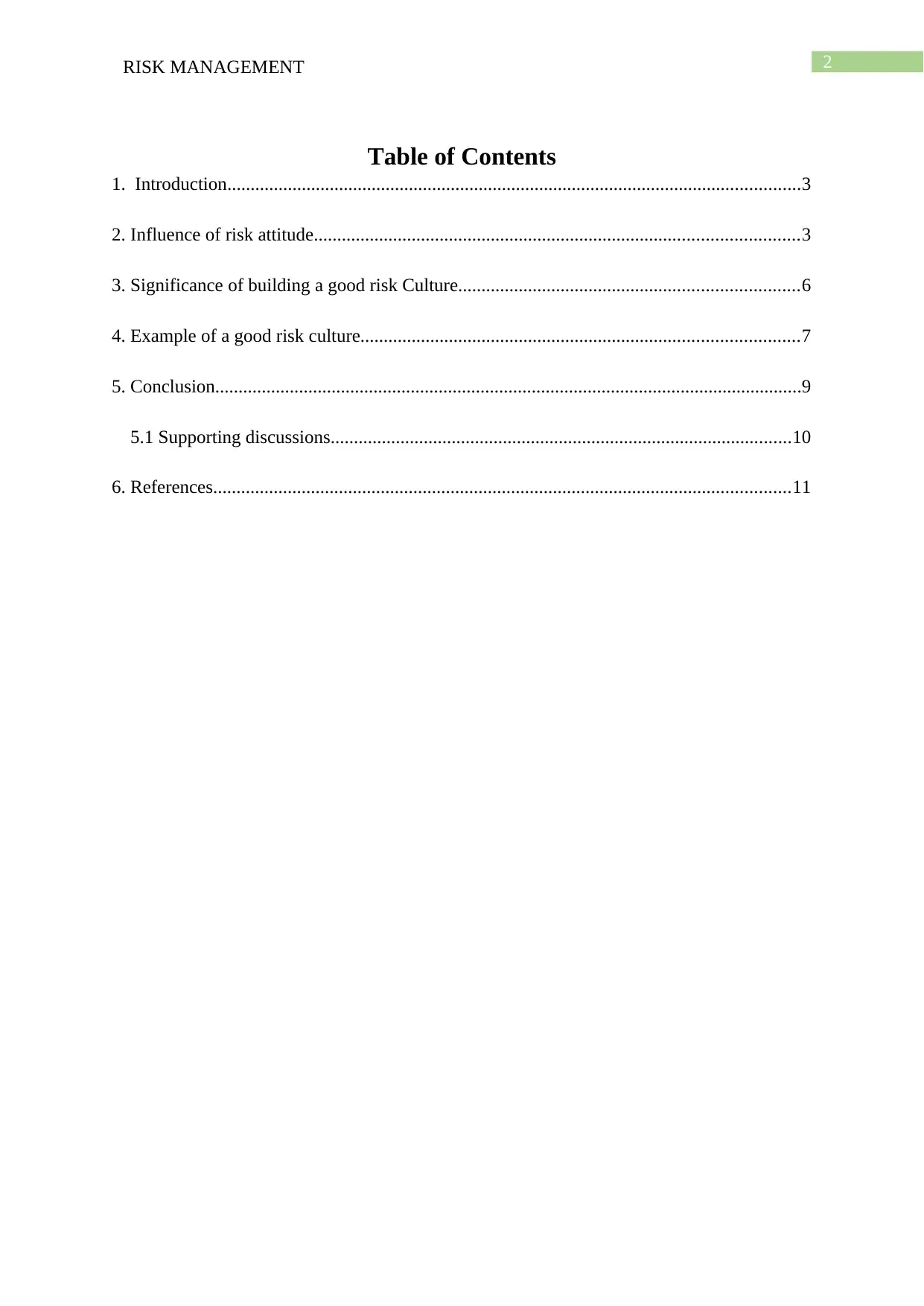
2RISK MANAGEMENT
Table of Contents
1. Introduction...........................................................................................................................3
2. Influence of risk attitude........................................................................................................3
3. Significance of building a good risk Culture.........................................................................6
4. Example of a good risk culture..............................................................................................7
5. Conclusion..............................................................................................................................9
5.1 Supporting discussions...................................................................................................10
6. References............................................................................................................................11
Table of Contents
1. Introduction...........................................................................................................................3
2. Influence of risk attitude........................................................................................................3
3. Significance of building a good risk Culture.........................................................................6
4. Example of a good risk culture..............................................................................................7
5. Conclusion..............................................................................................................................9
5.1 Supporting discussions...................................................................................................10
6. References............................................................................................................................11
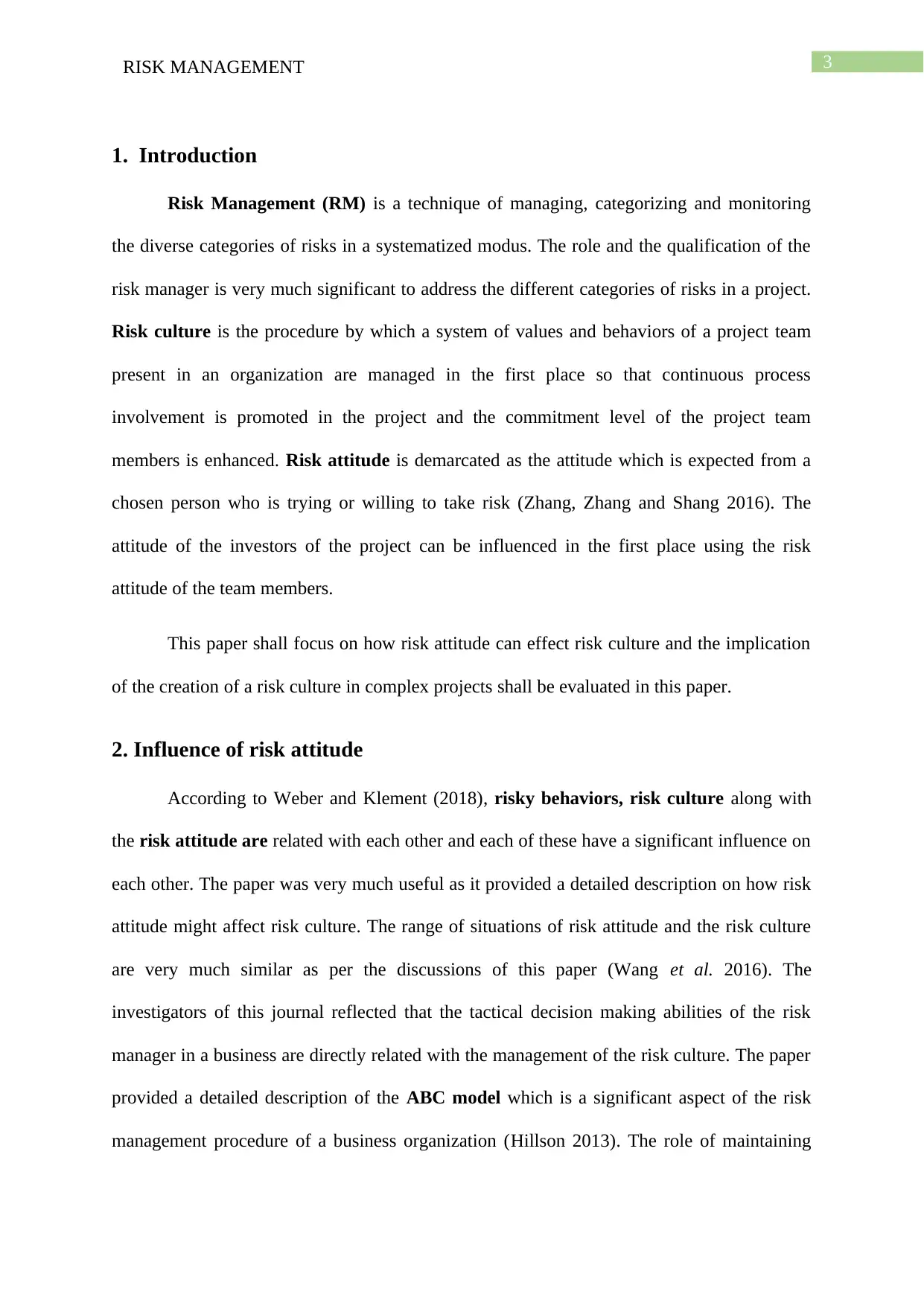
3RISK MANAGEMENT
1. Introduction
Risk Management (RM) is a technique of managing, categorizing and monitoring
the diverse categories of risks in a systematized modus. The role and the qualification of the
risk manager is very much significant to address the different categories of risks in a project.
Risk culture is the procedure by which a system of values and behaviors of a project team
present in an organization are managed in the first place so that continuous process
involvement is promoted in the project and the commitment level of the project team
members is enhanced. Risk attitude is demarcated as the attitude which is expected from a
chosen person who is trying or willing to take risk (Zhang, Zhang and Shang 2016). The
attitude of the investors of the project can be influenced in the first place using the risk
attitude of the team members.
This paper shall focus on how risk attitude can effect risk culture and the implication
of the creation of a risk culture in complex projects shall be evaluated in this paper.
2. Influence of risk attitude
According to Weber and Klement (2018), risky behaviors, risk culture along with
the risk attitude are related with each other and each of these have a significant influence on
each other. The paper was very much useful as it provided a detailed description on how risk
attitude might affect risk culture. The range of situations of risk attitude and the risk culture
are very much similar as per the discussions of this paper (Wang et al. 2016). The
investigators of this journal reflected that the tactical decision making abilities of the risk
manager in a business are directly related with the management of the risk culture. The paper
provided a detailed description of the ABC model which is a significant aspect of the risk
management procedure of a business organization (Hillson 2013). The role of maintaining
1. Introduction
Risk Management (RM) is a technique of managing, categorizing and monitoring
the diverse categories of risks in a systematized modus. The role and the qualification of the
risk manager is very much significant to address the different categories of risks in a project.
Risk culture is the procedure by which a system of values and behaviors of a project team
present in an organization are managed in the first place so that continuous process
involvement is promoted in the project and the commitment level of the project team
members is enhanced. Risk attitude is demarcated as the attitude which is expected from a
chosen person who is trying or willing to take risk (Zhang, Zhang and Shang 2016). The
attitude of the investors of the project can be influenced in the first place using the risk
attitude of the team members.
This paper shall focus on how risk attitude can effect risk culture and the implication
of the creation of a risk culture in complex projects shall be evaluated in this paper.
2. Influence of risk attitude
According to Weber and Klement (2018), risky behaviors, risk culture along with
the risk attitude are related with each other and each of these have a significant influence on
each other. The paper was very much useful as it provided a detailed description on how risk
attitude might affect risk culture. The range of situations of risk attitude and the risk culture
are very much similar as per the discussions of this paper (Wang et al. 2016). The
investigators of this journal reflected that the tactical decision making abilities of the risk
manager in a business are directly related with the management of the risk culture. The paper
provided a detailed description of the ABC model which is a significant aspect of the risk
management procedure of a business organization (Hillson 2013). The role of maintaining
Secure Best Marks with AI Grader
Need help grading? Try our AI Grader for instant feedback on your assignments.
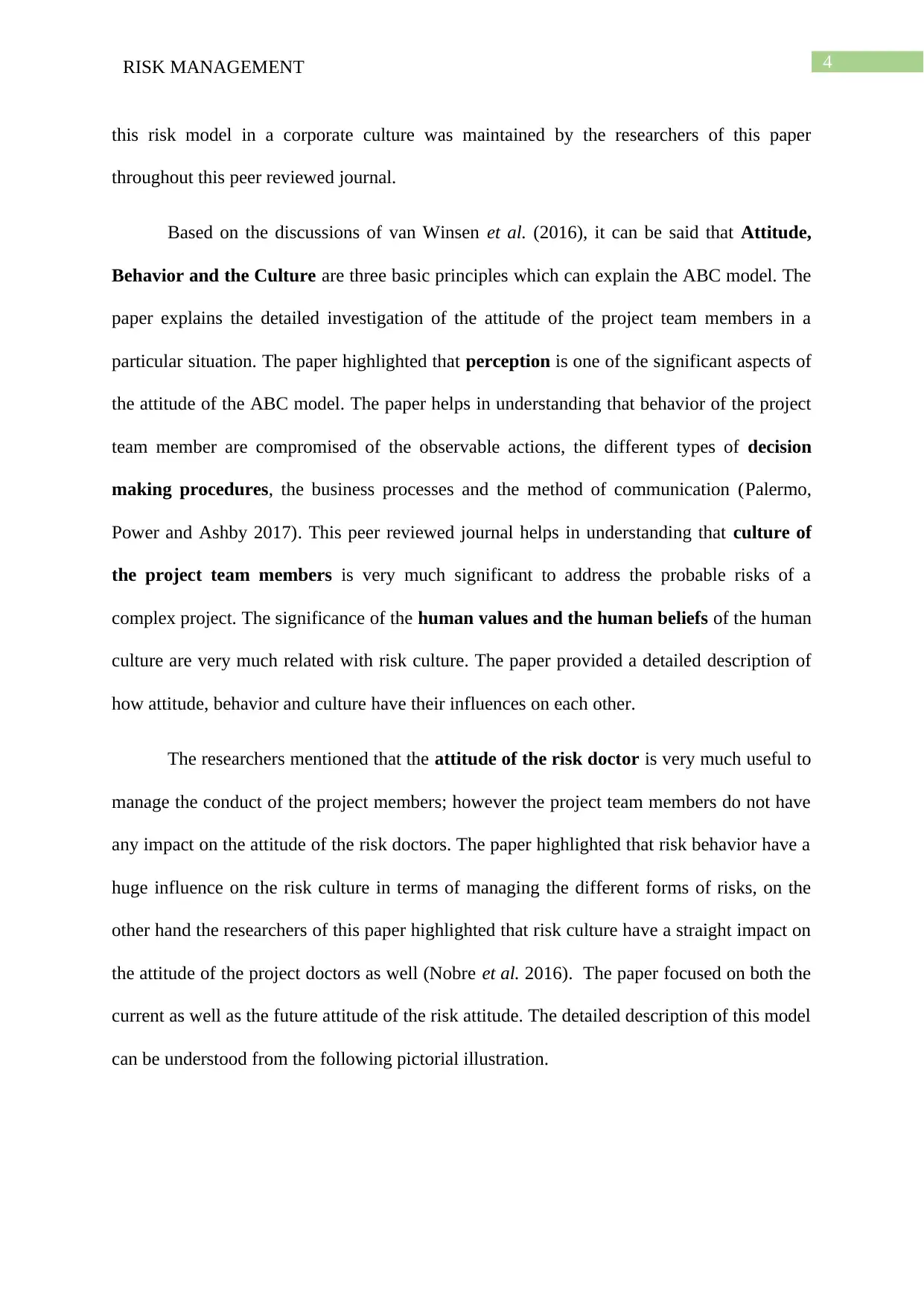
4RISK MANAGEMENT
this risk model in a corporate culture was maintained by the researchers of this paper
throughout this peer reviewed journal.
Based on the discussions of van Winsen et al. (2016), it can be said that Attitude,
Behavior and the Culture are three basic principles which can explain the ABC model. The
paper explains the detailed investigation of the attitude of the project team members in a
particular situation. The paper highlighted that perception is one of the significant aspects of
the attitude of the ABC model. The paper helps in understanding that behavior of the project
team member are compromised of the observable actions, the different types of decision
making procedures, the business processes and the method of communication (Palermo,
Power and Ashby 2017). This peer reviewed journal helps in understanding that culture of
the project team members is very much significant to address the probable risks of a
complex project. The significance of the human values and the human beliefs of the human
culture are very much related with risk culture. The paper provided a detailed description of
how attitude, behavior and culture have their influences on each other.
The researchers mentioned that the attitude of the risk doctor is very much useful to
manage the conduct of the project members; however the project team members do not have
any impact on the attitude of the risk doctors. The paper highlighted that risk behavior have a
huge influence on the risk culture in terms of managing the different forms of risks, on the
other hand the researchers of this paper highlighted that risk culture have a straight impact on
the attitude of the project doctors as well (Nobre et al. 2016). The paper focused on both the
current as well as the future attitude of the risk attitude. The detailed description of this model
can be understood from the following pictorial illustration.
this risk model in a corporate culture was maintained by the researchers of this paper
throughout this peer reviewed journal.
Based on the discussions of van Winsen et al. (2016), it can be said that Attitude,
Behavior and the Culture are three basic principles which can explain the ABC model. The
paper explains the detailed investigation of the attitude of the project team members in a
particular situation. The paper highlighted that perception is one of the significant aspects of
the attitude of the ABC model. The paper helps in understanding that behavior of the project
team member are compromised of the observable actions, the different types of decision
making procedures, the business processes and the method of communication (Palermo,
Power and Ashby 2017). This peer reviewed journal helps in understanding that culture of
the project team members is very much significant to address the probable risks of a
complex project. The significance of the human values and the human beliefs of the human
culture are very much related with risk culture. The paper provided a detailed description of
how attitude, behavior and culture have their influences on each other.
The researchers mentioned that the attitude of the risk doctor is very much useful to
manage the conduct of the project members; however the project team members do not have
any impact on the attitude of the risk doctors. The paper highlighted that risk behavior have a
huge influence on the risk culture in terms of managing the different forms of risks, on the
other hand the researchers of this paper highlighted that risk culture have a straight impact on
the attitude of the project doctors as well (Nobre et al. 2016). The paper focused on both the
current as well as the future attitude of the risk attitude. The detailed description of this model
can be understood from the following pictorial illustration.
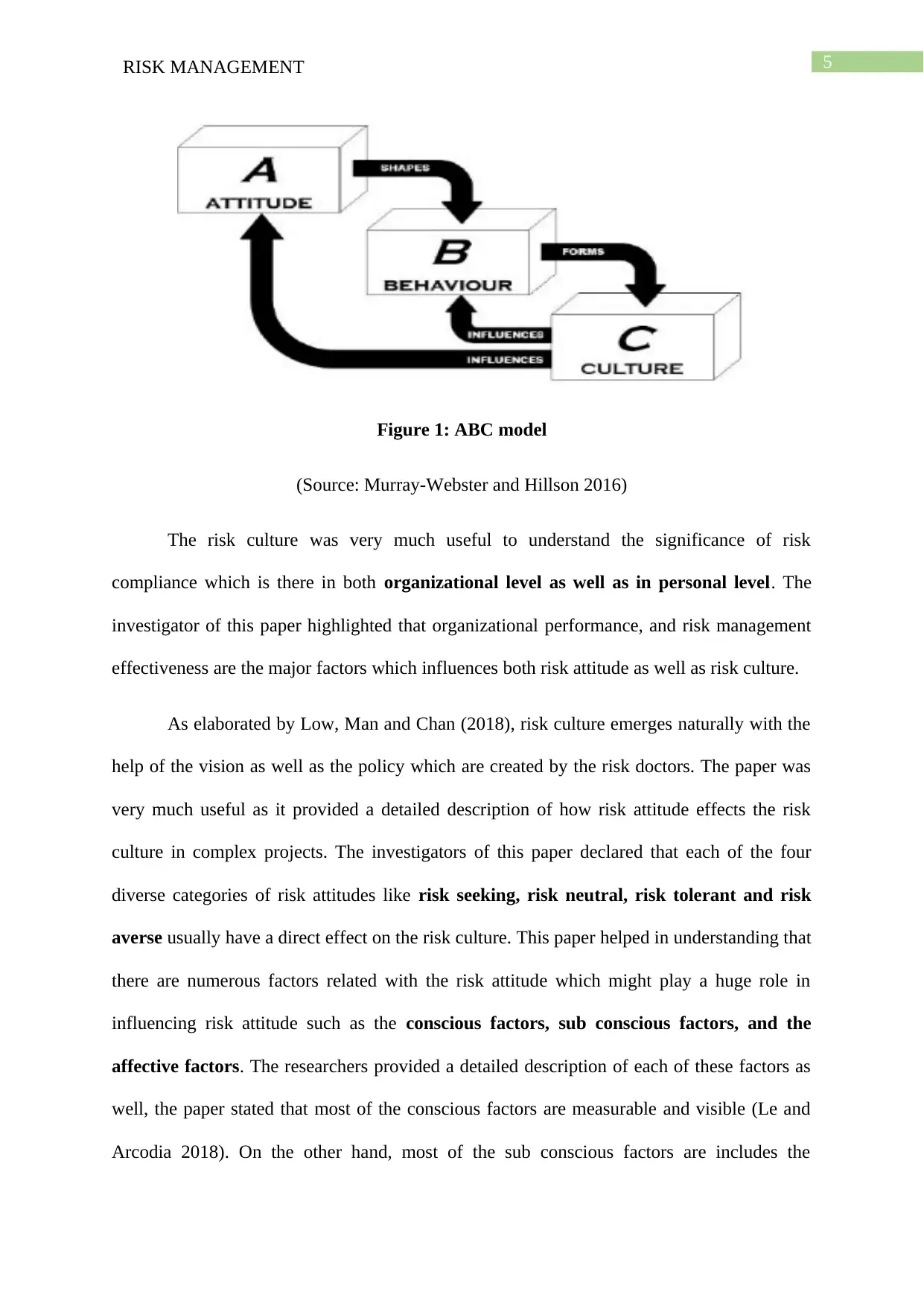
5RISK MANAGEMENT
Figure 1: ABC model
(Source: Murray-Webster and Hillson 2016)
The risk culture was very much useful to understand the significance of risk
compliance which is there in both organizational level as well as in personal level. The
investigator of this paper highlighted that organizational performance, and risk management
effectiveness are the major factors which influences both risk attitude as well as risk culture.
As elaborated by Low, Man and Chan (2018), risk culture emerges naturally with the
help of the vision as well as the policy which are created by the risk doctors. The paper was
very much useful as it provided a detailed description of how risk attitude effects the risk
culture in complex projects. The investigators of this paper declared that each of the four
diverse categories of risk attitudes like risk seeking, risk neutral, risk tolerant and risk
averse usually have a direct effect on the risk culture. This paper helped in understanding that
there are numerous factors related with the risk attitude which might play a huge role in
influencing risk attitude such as the conscious factors, sub conscious factors, and the
affective factors. The researchers provided a detailed description of each of these factors as
well, the paper stated that most of the conscious factors are measurable and visible (Le and
Arcodia 2018). On the other hand, most of the sub conscious factors are includes the
Figure 1: ABC model
(Source: Murray-Webster and Hillson 2016)
The risk culture was very much useful to understand the significance of risk
compliance which is there in both organizational level as well as in personal level. The
investigator of this paper highlighted that organizational performance, and risk management
effectiveness are the major factors which influences both risk attitude as well as risk culture.
As elaborated by Low, Man and Chan (2018), risk culture emerges naturally with the
help of the vision as well as the policy which are created by the risk doctors. The paper was
very much useful as it provided a detailed description of how risk attitude effects the risk
culture in complex projects. The investigators of this paper declared that each of the four
diverse categories of risk attitudes like risk seeking, risk neutral, risk tolerant and risk
averse usually have a direct effect on the risk culture. This paper helped in understanding that
there are numerous factors related with the risk attitude which might play a huge role in
influencing risk attitude such as the conscious factors, sub conscious factors, and the
affective factors. The researchers provided a detailed description of each of these factors as
well, the paper stated that most of the conscious factors are measurable and visible (Le and
Arcodia 2018). On the other hand, most of the sub conscious factors are includes the
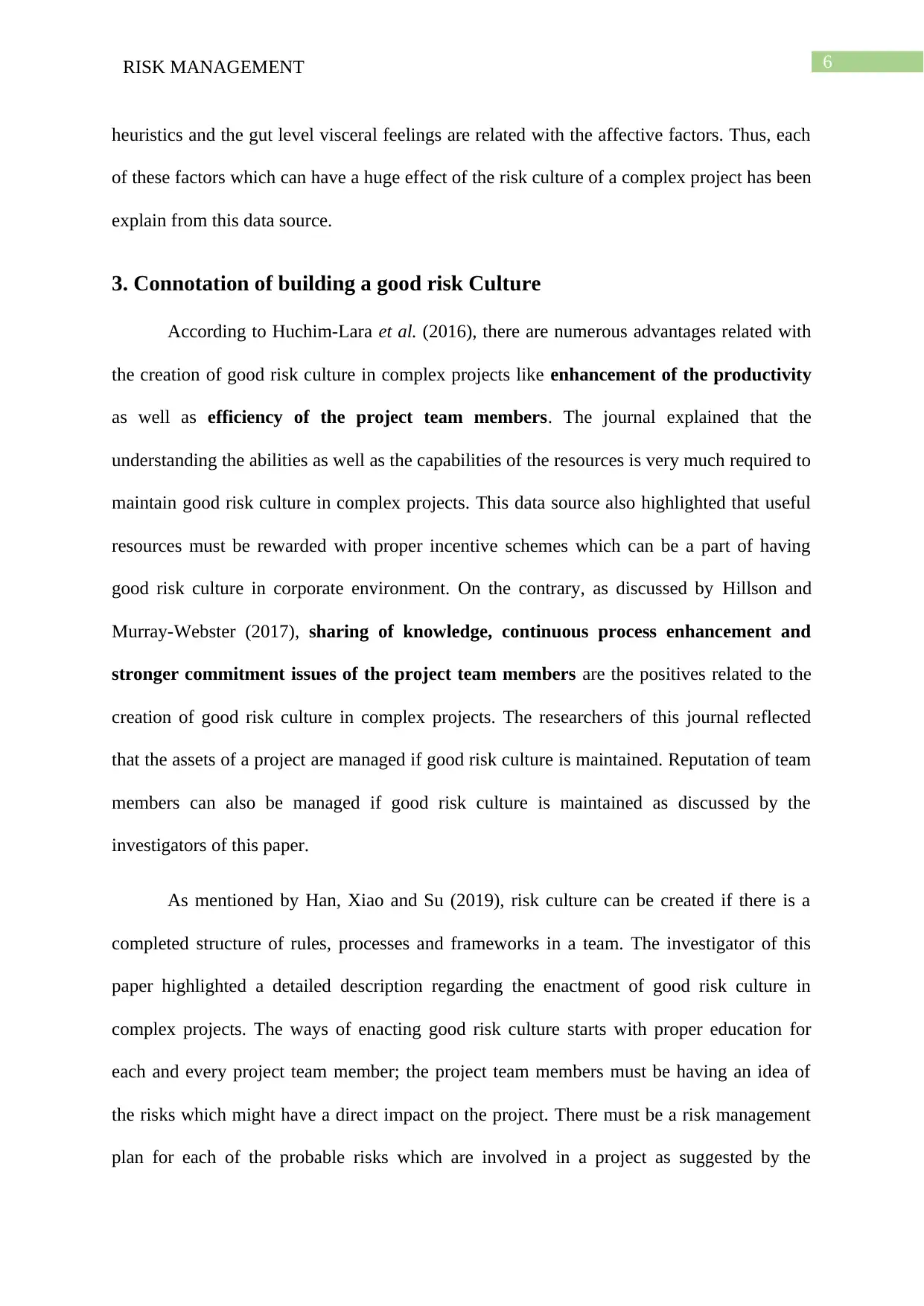
6RISK MANAGEMENT
heuristics and the gut level visceral feelings are related with the affective factors. Thus, each
of these factors which can have a huge effect of the risk culture of a complex project has been
explain from this data source.
3. Connotation of building a good risk Culture
According to Huchim-Lara et al. (2016), there are numerous advantages related with
the creation of good risk culture in complex projects like enhancement of the productivity
as well as efficiency of the project team members. The journal explained that the
understanding the abilities as well as the capabilities of the resources is very much required to
maintain good risk culture in complex projects. This data source also highlighted that useful
resources must be rewarded with proper incentive schemes which can be a part of having
good risk culture in corporate environment. On the contrary, as discussed by Hillson and
Murray-Webster (2017), sharing of knowledge, continuous process enhancement and
stronger commitment issues of the project team members are the positives related to the
creation of good risk culture in complex projects. The researchers of this journal reflected
that the assets of a project are managed if good risk culture is maintained. Reputation of team
members can also be managed if good risk culture is maintained as discussed by the
investigators of this paper.
As mentioned by Han, Xiao and Su (2019), risk culture can be created if there is a
completed structure of rules, processes and frameworks in a team. The investigator of this
paper highlighted a detailed description regarding the enactment of good risk culture in
complex projects. The ways of enacting good risk culture starts with proper education for
each and every project team member; the project team members must be having an idea of
the risks which might have a direct impact on the project. There must be a risk management
plan for each of the probable risks which are involved in a project as suggested by the
heuristics and the gut level visceral feelings are related with the affective factors. Thus, each
of these factors which can have a huge effect of the risk culture of a complex project has been
explain from this data source.
3. Connotation of building a good risk Culture
According to Huchim-Lara et al. (2016), there are numerous advantages related with
the creation of good risk culture in complex projects like enhancement of the productivity
as well as efficiency of the project team members. The journal explained that the
understanding the abilities as well as the capabilities of the resources is very much required to
maintain good risk culture in complex projects. This data source also highlighted that useful
resources must be rewarded with proper incentive schemes which can be a part of having
good risk culture in corporate environment. On the contrary, as discussed by Hillson and
Murray-Webster (2017), sharing of knowledge, continuous process enhancement and
stronger commitment issues of the project team members are the positives related to the
creation of good risk culture in complex projects. The researchers of this journal reflected
that the assets of a project are managed if good risk culture is maintained. Reputation of team
members can also be managed if good risk culture is maintained as discussed by the
investigators of this paper.
As mentioned by Han, Xiao and Su (2019), risk culture can be created if there is a
completed structure of rules, processes and frameworks in a team. The investigator of this
paper highlighted a detailed description regarding the enactment of good risk culture in
complex projects. The ways of enacting good risk culture starts with proper education for
each and every project team member; the project team members must be having an idea of
the risks which might have a direct impact on the project. There must be a risk management
plan for each of the probable risks which are involved in a project as suggested by the
Paraphrase This Document
Need a fresh take? Get an instant paraphrase of this document with our AI Paraphraser
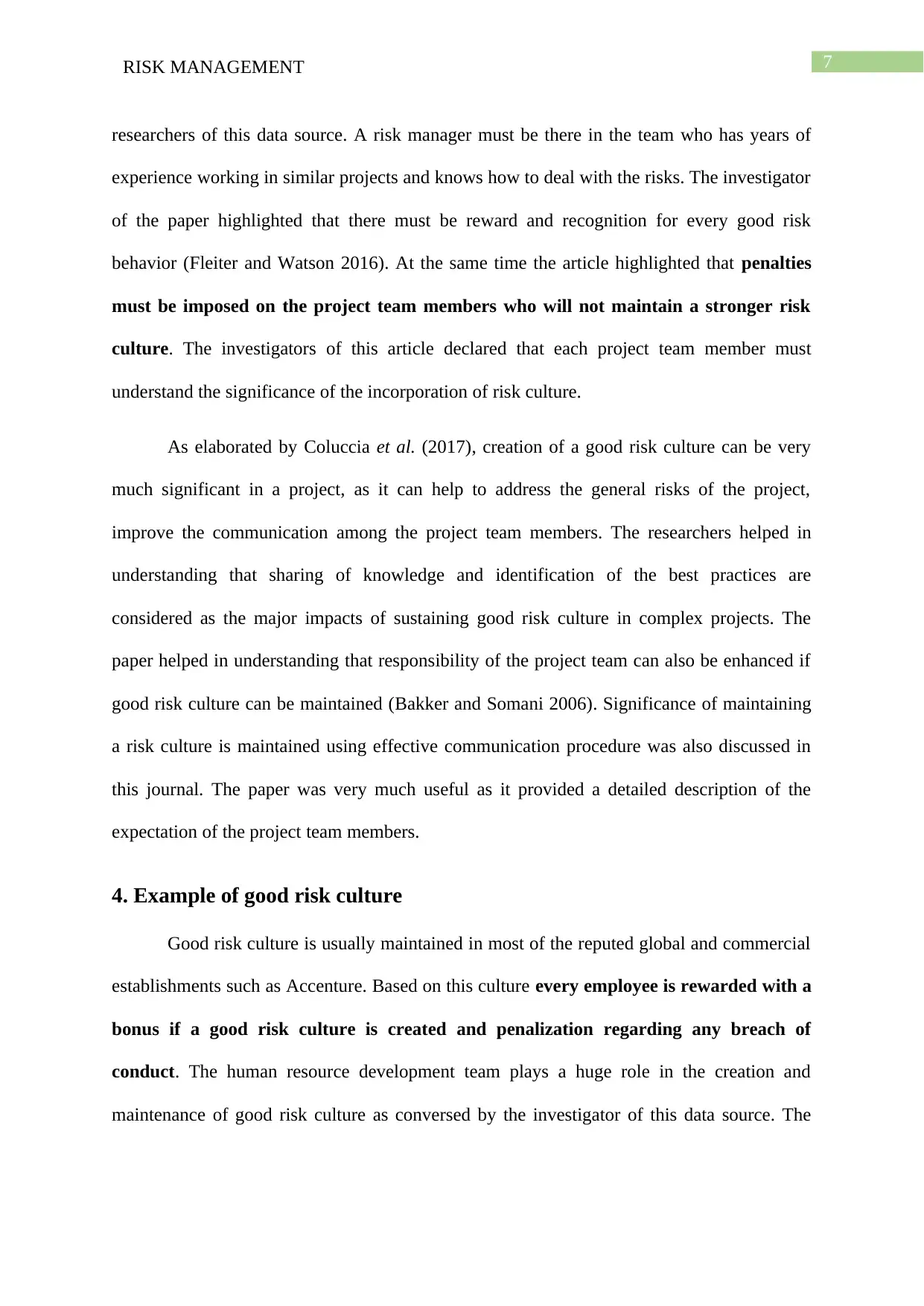
7RISK MANAGEMENT
researchers of this data source. A risk manager must be there in the team who has years of
experience working in similar projects and knows how to deal with the risks. The investigator
of the paper highlighted that there must be reward and recognition for every good risk
behavior (Fleiter and Watson 2016). At the same time the article highlighted that penalties
must be imposed on the project team members who will not maintain a stronger risk
culture. The investigators of this article declared that each project team member must
understand the significance of the incorporation of risk culture.
As elaborated by Coluccia et al. (2017), creation of a good risk culture can be very
much significant in a project, as it can help to address the general risks of the project,
improve the communication among the project team members. The researchers helped in
understanding that sharing of knowledge and identification of the best practices are
considered as the major impacts of sustaining good risk culture in complex projects. The
paper helped in understanding that responsibility of the project team can also be enhanced if
good risk culture can be maintained (Bakker and Somani 2006). Significance of maintaining
a risk culture is maintained using effective communication procedure was also discussed in
this journal. The paper was very much useful as it provided a detailed description of the
expectation of the project team members.
4. Example of good risk culture
Good risk culture is usually maintained in most of the reputed global and commercial
establishments such as Accenture. Based on this culture every employee is rewarded with a
bonus if a good risk culture is created and penalization regarding any breach of
conduct. The human resource development team plays a huge role in the creation and
maintenance of good risk culture as conversed by the investigator of this data source. The
researchers of this data source. A risk manager must be there in the team who has years of
experience working in similar projects and knows how to deal with the risks. The investigator
of the paper highlighted that there must be reward and recognition for every good risk
behavior (Fleiter and Watson 2016). At the same time the article highlighted that penalties
must be imposed on the project team members who will not maintain a stronger risk
culture. The investigators of this article declared that each project team member must
understand the significance of the incorporation of risk culture.
As elaborated by Coluccia et al. (2017), creation of a good risk culture can be very
much significant in a project, as it can help to address the general risks of the project,
improve the communication among the project team members. The researchers helped in
understanding that sharing of knowledge and identification of the best practices are
considered as the major impacts of sustaining good risk culture in complex projects. The
paper helped in understanding that responsibility of the project team can also be enhanced if
good risk culture can be maintained (Bakker and Somani 2006). Significance of maintaining
a risk culture is maintained using effective communication procedure was also discussed in
this journal. The paper was very much useful as it provided a detailed description of the
expectation of the project team members.
4. Example of good risk culture
Good risk culture is usually maintained in most of the reputed global and commercial
establishments such as Accenture. Based on this culture every employee is rewarded with a
bonus if a good risk culture is created and penalization regarding any breach of
conduct. The human resource development team plays a huge role in the creation and
maintenance of good risk culture as conversed by the investigator of this data source. The
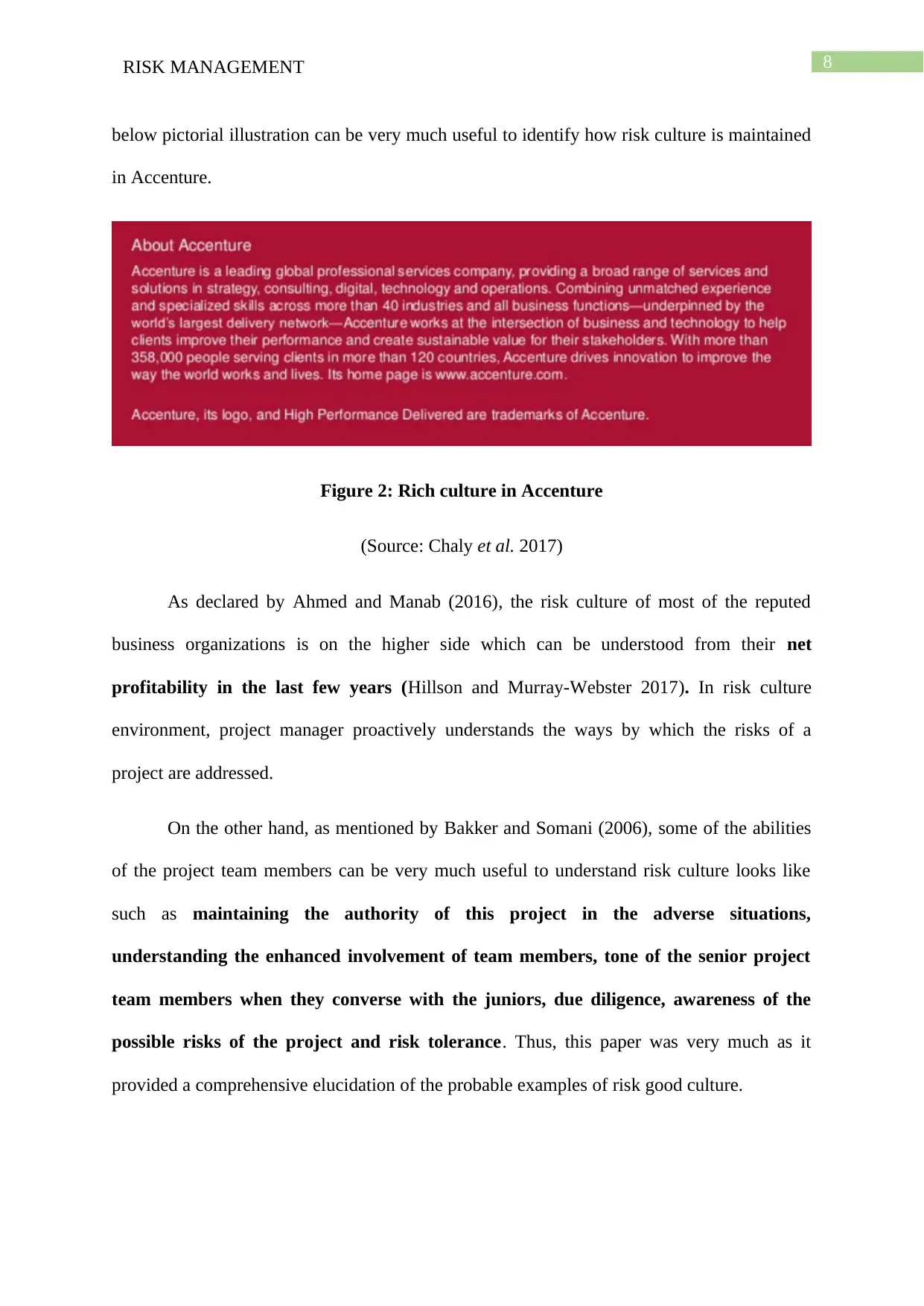
8RISK MANAGEMENT
below pictorial illustration can be very much useful to identify how risk culture is maintained
in Accenture.
Figure 2: Rich culture in Accenture
(Source: Chaly et al. 2017)
As declared by Ahmed and Manab (2016), the risk culture of most of the reputed
business organizations is on the higher side which can be understood from their net
profitability in the last few years (Hillson and Murray-Webster 2017). In risk culture
environment, project manager proactively understands the ways by which the risks of a
project are addressed.
On the other hand, as mentioned by Bakker and Somani (2006), some of the abilities
of the project team members can be very much useful to understand risk culture looks like
such as maintaining the authority of this project in the adverse situations,
understanding the enhanced involvement of team members, tone of the senior project
team members when they converse with the juniors, due diligence, awareness of the
possible risks of the project and risk tolerance. Thus, this paper was very much as it
provided a comprehensive elucidation of the probable examples of risk good culture.
below pictorial illustration can be very much useful to identify how risk culture is maintained
in Accenture.
Figure 2: Rich culture in Accenture
(Source: Chaly et al. 2017)
As declared by Ahmed and Manab (2016), the risk culture of most of the reputed
business organizations is on the higher side which can be understood from their net
profitability in the last few years (Hillson and Murray-Webster 2017). In risk culture
environment, project manager proactively understands the ways by which the risks of a
project are addressed.
On the other hand, as mentioned by Bakker and Somani (2006), some of the abilities
of the project team members can be very much useful to understand risk culture looks like
such as maintaining the authority of this project in the adverse situations,
understanding the enhanced involvement of team members, tone of the senior project
team members when they converse with the juniors, due diligence, awareness of the
possible risks of the project and risk tolerance. Thus, this paper was very much as it
provided a comprehensive elucidation of the probable examples of risk good culture.
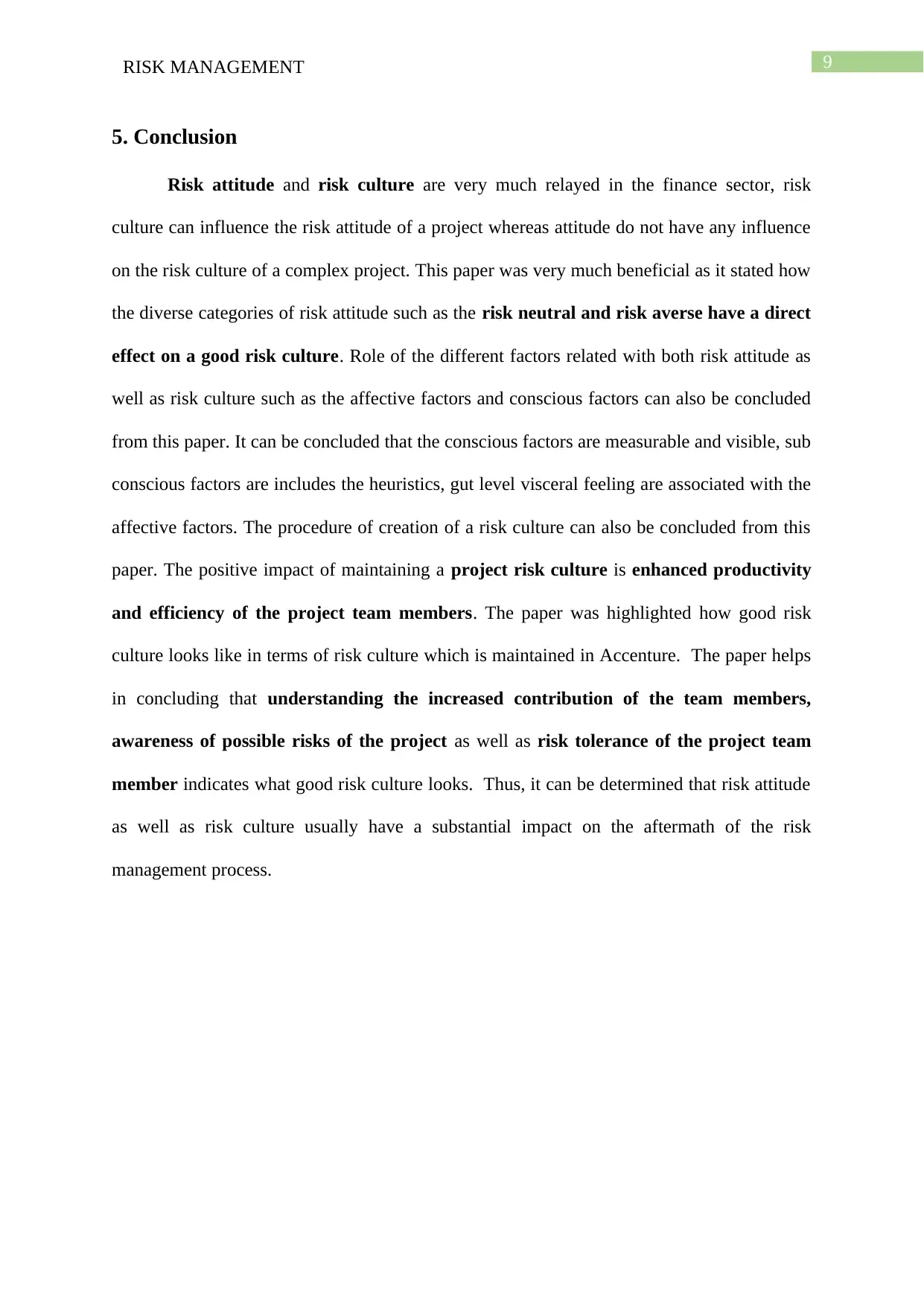
9RISK MANAGEMENT
5. Conclusion
Risk attitude and risk culture are very much relayed in the finance sector, risk
culture can influence the risk attitude of a project whereas attitude do not have any influence
on the risk culture of a complex project. This paper was very much beneficial as it stated how
the diverse categories of risk attitude such as the risk neutral and risk averse have a direct
effect on a good risk culture. Role of the different factors related with both risk attitude as
well as risk culture such as the affective factors and conscious factors can also be concluded
from this paper. It can be concluded that the conscious factors are measurable and visible, sub
conscious factors are includes the heuristics, gut level visceral feeling are associated with the
affective factors. The procedure of creation of a risk culture can also be concluded from this
paper. The positive impact of maintaining a project risk culture is enhanced productivity
and efficiency of the project team members. The paper was highlighted how good risk
culture looks like in terms of risk culture which is maintained in Accenture. The paper helps
in concluding that understanding the increased contribution of the team members,
awareness of possible risks of the project as well as risk tolerance of the project team
member indicates what good risk culture looks. Thus, it can be determined that risk attitude
as well as risk culture usually have a substantial impact on the aftermath of the risk
management process.
5. Conclusion
Risk attitude and risk culture are very much relayed in the finance sector, risk
culture can influence the risk attitude of a project whereas attitude do not have any influence
on the risk culture of a complex project. This paper was very much beneficial as it stated how
the diverse categories of risk attitude such as the risk neutral and risk averse have a direct
effect on a good risk culture. Role of the different factors related with both risk attitude as
well as risk culture such as the affective factors and conscious factors can also be concluded
from this paper. It can be concluded that the conscious factors are measurable and visible, sub
conscious factors are includes the heuristics, gut level visceral feeling are associated with the
affective factors. The procedure of creation of a risk culture can also be concluded from this
paper. The positive impact of maintaining a project risk culture is enhanced productivity
and efficiency of the project team members. The paper was highlighted how good risk
culture looks like in terms of risk culture which is maintained in Accenture. The paper helps
in concluding that understanding the increased contribution of the team members,
awareness of possible risks of the project as well as risk tolerance of the project team
member indicates what good risk culture looks. Thus, it can be determined that risk attitude
as well as risk culture usually have a substantial impact on the aftermath of the risk
management process.
Secure Best Marks with AI Grader
Need help grading? Try our AI Grader for instant feedback on your assignments.
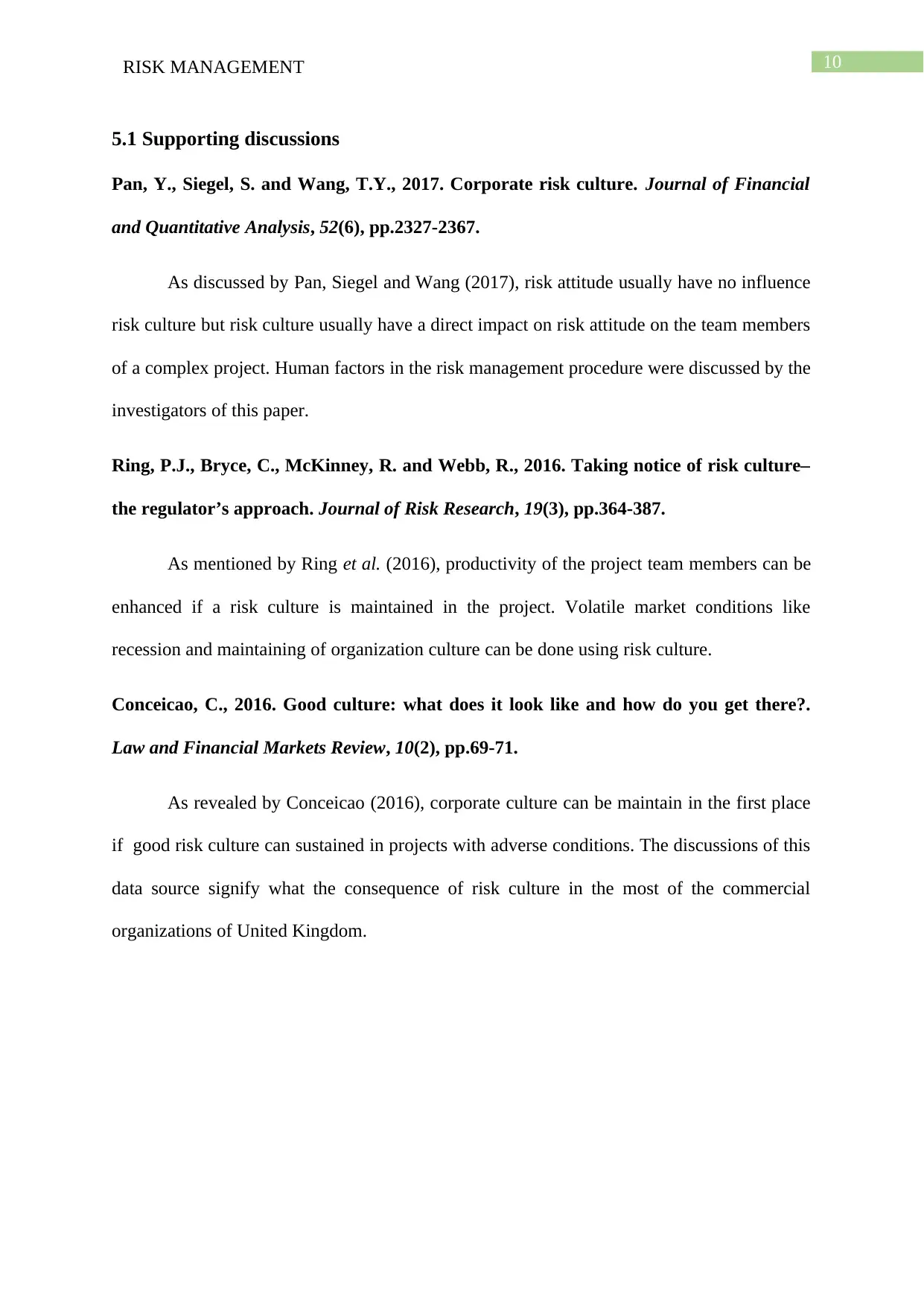
10RISK MANAGEMENT
5.1 Supporting discussions
Pan, Y., Siegel, S. and Wang, T.Y., 2017. Corporate risk culture. Journal of Financial
and Quantitative Analysis, 52(6), pp.2327-2367.
As discussed by Pan, Siegel and Wang (2017), risk attitude usually have no influence
risk culture but risk culture usually have a direct impact on risk attitude on the team members
of a complex project. Human factors in the risk management procedure were discussed by the
investigators of this paper.
Ring, P.J., Bryce, C., McKinney, R. and Webb, R., 2016. Taking notice of risk culture–
the regulator’s approach. Journal of Risk Research, 19(3), pp.364-387.
As mentioned by Ring et al. (2016), productivity of the project team members can be
enhanced if a risk culture is maintained in the project. Volatile market conditions like
recession and maintaining of organization culture can be done using risk culture.
Conceicao, C., 2016. Good culture: what does it look like and how do you get there?.
Law and Financial Markets Review, 10(2), pp.69-71.
As revealed by Conceicao (2016), corporate culture can be maintain in the first place
if good risk culture can sustained in projects with adverse conditions. The discussions of this
data source signify what the consequence of risk culture in the most of the commercial
organizations of United Kingdom.
5.1 Supporting discussions
Pan, Y., Siegel, S. and Wang, T.Y., 2017. Corporate risk culture. Journal of Financial
and Quantitative Analysis, 52(6), pp.2327-2367.
As discussed by Pan, Siegel and Wang (2017), risk attitude usually have no influence
risk culture but risk culture usually have a direct impact on risk attitude on the team members
of a complex project. Human factors in the risk management procedure were discussed by the
investigators of this paper.
Ring, P.J., Bryce, C., McKinney, R. and Webb, R., 2016. Taking notice of risk culture–
the regulator’s approach. Journal of Risk Research, 19(3), pp.364-387.
As mentioned by Ring et al. (2016), productivity of the project team members can be
enhanced if a risk culture is maintained in the project. Volatile market conditions like
recession and maintaining of organization culture can be done using risk culture.
Conceicao, C., 2016. Good culture: what does it look like and how do you get there?.
Law and Financial Markets Review, 10(2), pp.69-71.
As revealed by Conceicao (2016), corporate culture can be maintain in the first place
if good risk culture can sustained in projects with adverse conditions. The discussions of this
data source signify what the consequence of risk culture in the most of the commercial
organizations of United Kingdom.
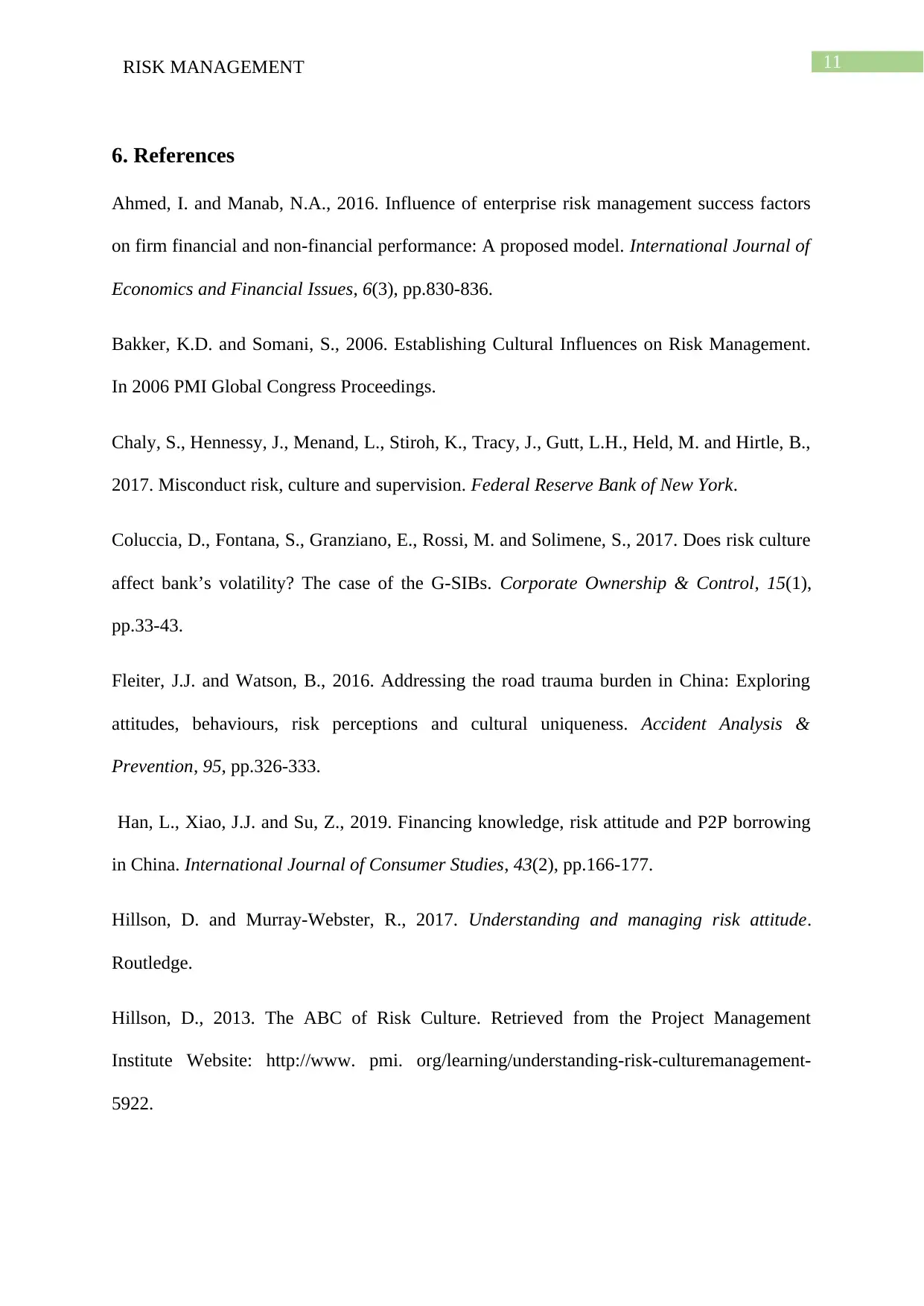
11RISK MANAGEMENT
6. References
Ahmed, I. and Manab, N.A., 2016. Influence of enterprise risk management success factors
on firm financial and non-financial performance: A proposed model. International Journal of
Economics and Financial Issues, 6(3), pp.830-836.
Bakker, K.D. and Somani, S., 2006. Establishing Cultural Influences on Risk Management.
In 2006 PMI Global Congress Proceedings.
Chaly, S., Hennessy, J., Menand, L., Stiroh, K., Tracy, J., Gutt, L.H., Held, M. and Hirtle, B.,
2017. Misconduct risk, culture and supervision. Federal Reserve Bank of New York.
Coluccia, D., Fontana, S., Granziano, E., Rossi, M. and Solimene, S., 2017. Does risk culture
affect bank’s volatility? The case of the G-SIBs. Corporate Ownership & Control, 15(1),
pp.33-43.
Fleiter, J.J. and Watson, B., 2016. Addressing the road trauma burden in China: Exploring
attitudes, behaviours, risk perceptions and cultural uniqueness. Accident Analysis &
Prevention, 95, pp.326-333.
Han, L., Xiao, J.J. and Su, Z., 2019. Financing knowledge, risk attitude and P2P borrowing
in China. International Journal of Consumer Studies, 43(2), pp.166-177.
Hillson, D. and Murray-Webster, R., 2017. Understanding and managing risk attitude.
Routledge.
Hillson, D., 2013. The ABC of Risk Culture. Retrieved from the Project Management
Institute Website: http://www. pmi. org/learning/understanding-risk-culturemanagement-
5922.
6. References
Ahmed, I. and Manab, N.A., 2016. Influence of enterprise risk management success factors
on firm financial and non-financial performance: A proposed model. International Journal of
Economics and Financial Issues, 6(3), pp.830-836.
Bakker, K.D. and Somani, S., 2006. Establishing Cultural Influences on Risk Management.
In 2006 PMI Global Congress Proceedings.
Chaly, S., Hennessy, J., Menand, L., Stiroh, K., Tracy, J., Gutt, L.H., Held, M. and Hirtle, B.,
2017. Misconduct risk, culture and supervision. Federal Reserve Bank of New York.
Coluccia, D., Fontana, S., Granziano, E., Rossi, M. and Solimene, S., 2017. Does risk culture
affect bank’s volatility? The case of the G-SIBs. Corporate Ownership & Control, 15(1),
pp.33-43.
Fleiter, J.J. and Watson, B., 2016. Addressing the road trauma burden in China: Exploring
attitudes, behaviours, risk perceptions and cultural uniqueness. Accident Analysis &
Prevention, 95, pp.326-333.
Han, L., Xiao, J.J. and Su, Z., 2019. Financing knowledge, risk attitude and P2P borrowing
in China. International Journal of Consumer Studies, 43(2), pp.166-177.
Hillson, D. and Murray-Webster, R., 2017. Understanding and managing risk attitude.
Routledge.
Hillson, D., 2013. The ABC of Risk Culture. Retrieved from the Project Management
Institute Website: http://www. pmi. org/learning/understanding-risk-culturemanagement-
5922.
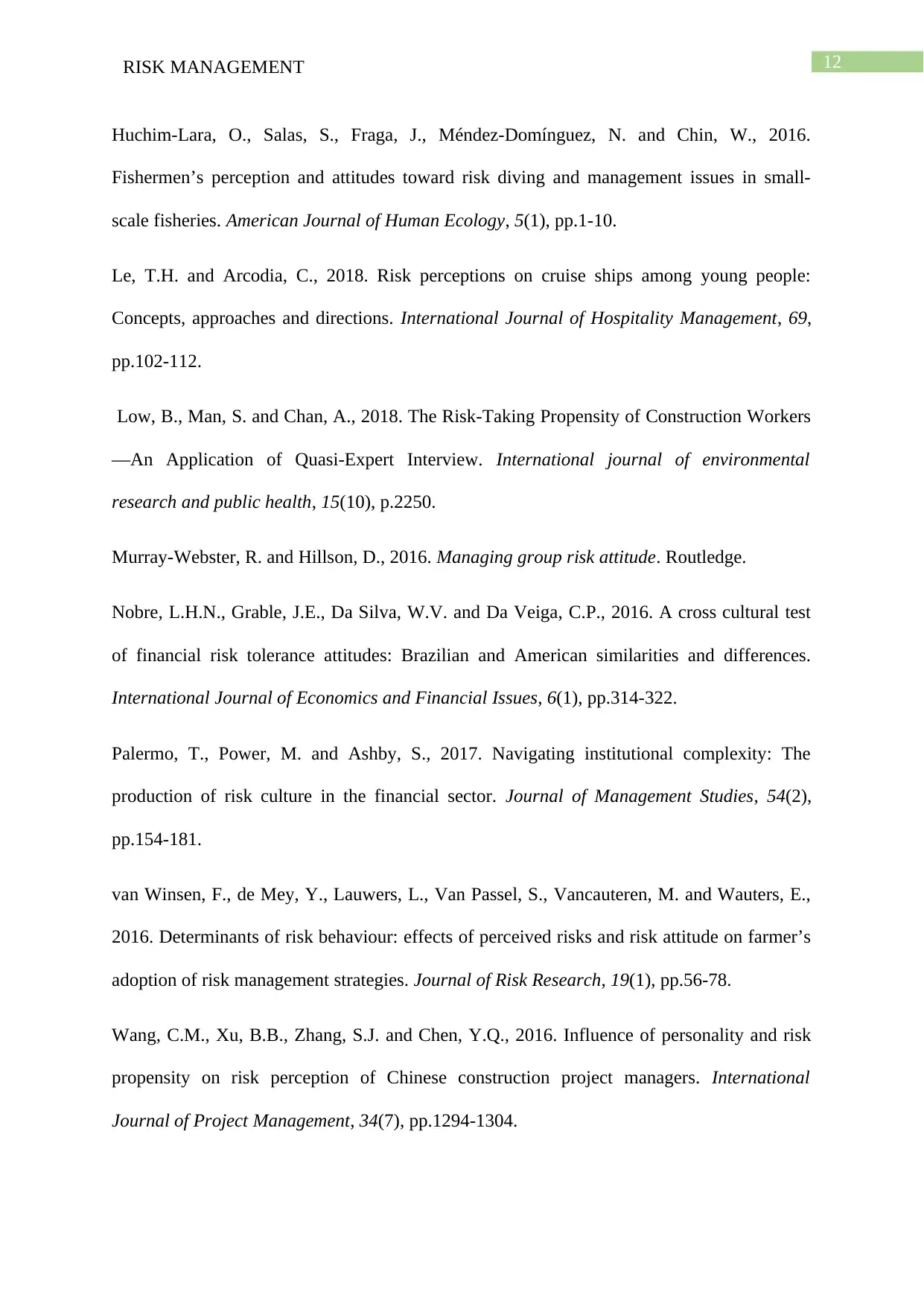
12RISK MANAGEMENT
Huchim-Lara, O., Salas, S., Fraga, J., Méndez-Domínguez, N. and Chin, W., 2016.
Fishermen’s perception and attitudes toward risk diving and management issues in small-
scale fisheries. American Journal of Human Ecology, 5(1), pp.1-10.
Le, T.H. and Arcodia, C., 2018. Risk perceptions on cruise ships among young people:
Concepts, approaches and directions. International Journal of Hospitality Management, 69,
pp.102-112.
Low, B., Man, S. and Chan, A., 2018. The Risk-Taking Propensity of Construction Workers
—An Application of Quasi-Expert Interview. International journal of environmental
research and public health, 15(10), p.2250.
Murray-Webster, R. and Hillson, D., 2016. Managing group risk attitude. Routledge.
Nobre, L.H.N., Grable, J.E., Da Silva, W.V. and Da Veiga, C.P., 2016. A cross cultural test
of financial risk tolerance attitudes: Brazilian and American similarities and differences.
International Journal of Economics and Financial Issues, 6(1), pp.314-322.
Palermo, T., Power, M. and Ashby, S., 2017. Navigating institutional complexity: The
production of risk culture in the financial sector. Journal of Management Studies, 54(2),
pp.154-181.
van Winsen, F., de Mey, Y., Lauwers, L., Van Passel, S., Vancauteren, M. and Wauters, E.,
2016. Determinants of risk behaviour: effects of perceived risks and risk attitude on farmer’s
adoption of risk management strategies. Journal of Risk Research, 19(1), pp.56-78.
Wang, C.M., Xu, B.B., Zhang, S.J. and Chen, Y.Q., 2016. Influence of personality and risk
propensity on risk perception of Chinese construction project managers. International
Journal of Project Management, 34(7), pp.1294-1304.
Huchim-Lara, O., Salas, S., Fraga, J., Méndez-Domínguez, N. and Chin, W., 2016.
Fishermen’s perception and attitudes toward risk diving and management issues in small-
scale fisheries. American Journal of Human Ecology, 5(1), pp.1-10.
Le, T.H. and Arcodia, C., 2018. Risk perceptions on cruise ships among young people:
Concepts, approaches and directions. International Journal of Hospitality Management, 69,
pp.102-112.
Low, B., Man, S. and Chan, A., 2018. The Risk-Taking Propensity of Construction Workers
—An Application of Quasi-Expert Interview. International journal of environmental
research and public health, 15(10), p.2250.
Murray-Webster, R. and Hillson, D., 2016. Managing group risk attitude. Routledge.
Nobre, L.H.N., Grable, J.E., Da Silva, W.V. and Da Veiga, C.P., 2016. A cross cultural test
of financial risk tolerance attitudes: Brazilian and American similarities and differences.
International Journal of Economics and Financial Issues, 6(1), pp.314-322.
Palermo, T., Power, M. and Ashby, S., 2017. Navigating institutional complexity: The
production of risk culture in the financial sector. Journal of Management Studies, 54(2),
pp.154-181.
van Winsen, F., de Mey, Y., Lauwers, L., Van Passel, S., Vancauteren, M. and Wauters, E.,
2016. Determinants of risk behaviour: effects of perceived risks and risk attitude on farmer’s
adoption of risk management strategies. Journal of Risk Research, 19(1), pp.56-78.
Wang, C.M., Xu, B.B., Zhang, S.J. and Chen, Y.Q., 2016. Influence of personality and risk
propensity on risk perception of Chinese construction project managers. International
Journal of Project Management, 34(7), pp.1294-1304.
Paraphrase This Document
Need a fresh take? Get an instant paraphrase of this document with our AI Paraphraser
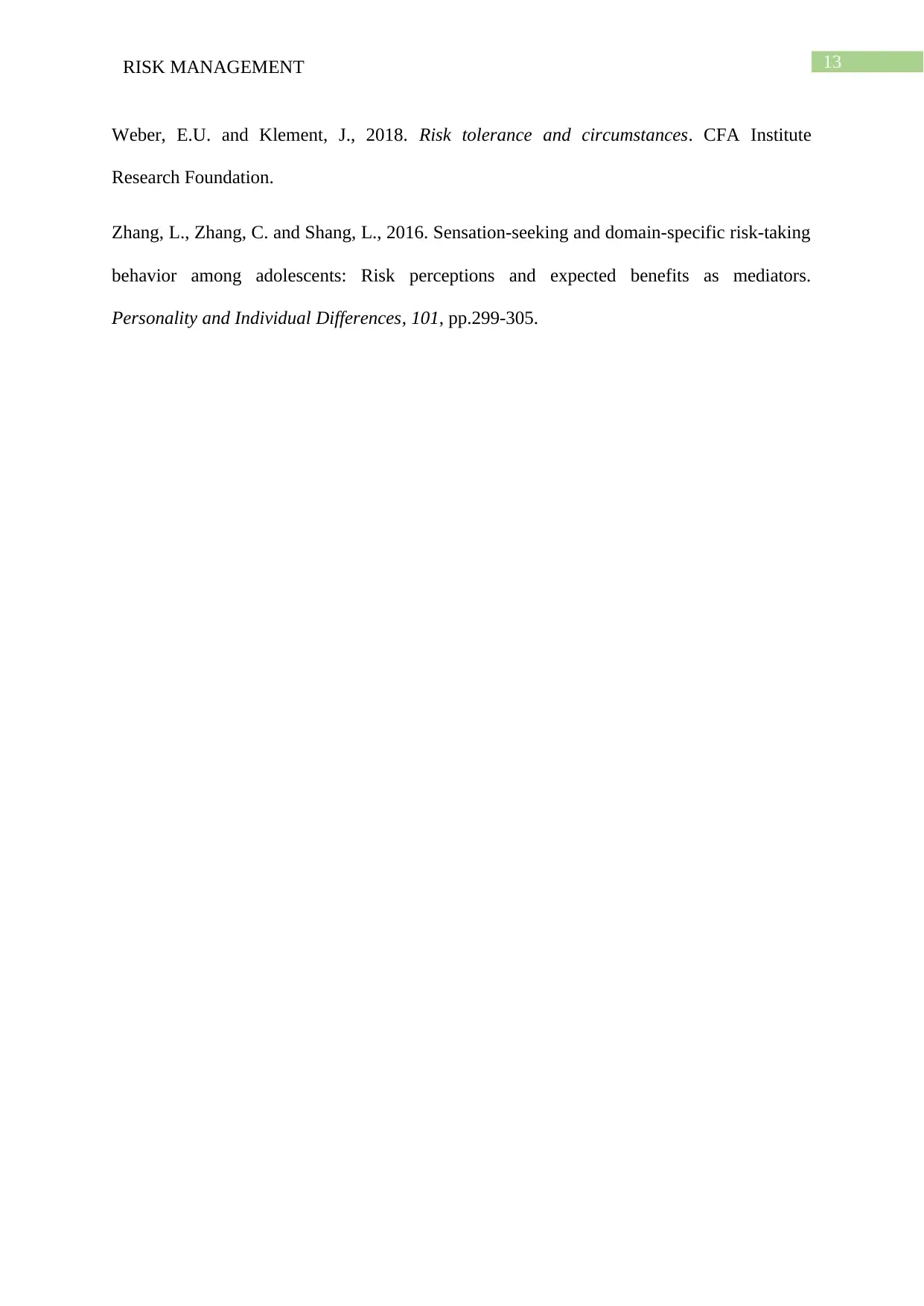
13RISK MANAGEMENT
Weber, E.U. and Klement, J., 2018. Risk tolerance and circumstances. CFA Institute
Research Foundation.
Zhang, L., Zhang, C. and Shang, L., 2016. Sensation-seeking and domain-specific risk-taking
behavior among adolescents: Risk perceptions and expected benefits as mediators.
Personality and Individual Differences, 101, pp.299-305.
Weber, E.U. and Klement, J., 2018. Risk tolerance and circumstances. CFA Institute
Research Foundation.
Zhang, L., Zhang, C. and Shang, L., 2016. Sensation-seeking and domain-specific risk-taking
behavior among adolescents: Risk perceptions and expected benefits as mediators.
Personality and Individual Differences, 101, pp.299-305.
1 out of 14
Related Documents
Your All-in-One AI-Powered Toolkit for Academic Success.
+13062052269
info@desklib.com
Available 24*7 on WhatsApp / Email
![[object Object]](/_next/static/media/star-bottom.7253800d.svg)
Unlock your academic potential
© 2024 | Zucol Services PVT LTD | All rights reserved.





